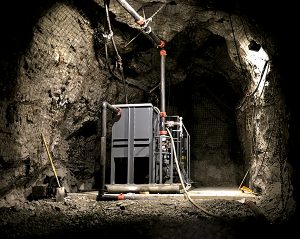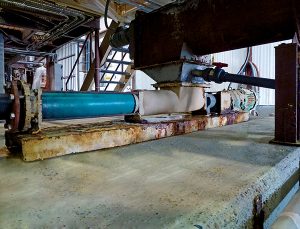The right pumping technology can boost safety and efficiency
The mining industry is supported by a vast system of pumps and pipes. Whether to transport slurries filled with product or to siphon away waste and excess water, pumps surround the operation. However, mined materials are not always soft, safe, and easy to handle. A lot of damage can be done to the pumps trying to transport these materials, costing money in repairs and compromising safety. In order to ensure safety and efficiency, it is important to install pumping equipment that can handle the job.

Underground pump installation. CREDIT: NETZSCH.
A great variety of media must be conveyed at mining projects. As companies penetrate deeper into the earth seeking natural resources, they encounter a host of extraneous and/or waste materials that must be siphoned away. Other times, the substance being mined is extracted from sludges and slurries created by the mining process. In this case, the material must be safely pumped away for further processing.
When mining for precious metals and minerals, rock bearing these substances is often crushed into a slurry that then must be transported for chemical extraction and processing via pumping systems. While water is sometimes added to make transport easier, many slurries are eventually thickened to help separate the desired solids and to help with waste management. The waste, or tailings, from processing and/or extraction, are pumped into a waste area or facility for later disposal.

A NEMO pump under a centrifuge at a yellow cake plant. CREDIT: NETZSCH
Pumps are also required to dose materials with additives, for example, when chemicals are added for treatment and processing, or flocculants are added to waste water to promote clumping and ease of filtration. Mining operations drain water from slurries of product to help extract the desired substance and from waste to simplify waste storage and minimize the potential for contamination.
Some mining requires more volatile practices such as the use of explosives or extraction of dangerous and/or radioactive materials. When explosives are needed, mining companies must be able to comply with special conveyance conditions to ensure safe transport. When mining materials such as uranium, companies must be able to safely transport the concentrated powder obtained from leach solutions known as yellow cake. All of these mining applications require proper pumping or conveyance methods to ensure safety and efficiency.
Challenges and safety concerns
Mining precious metals or hard minerals can place machines under extreme stress, increasing the chances for mechanical failure and the price of the raw material. The sludges and slurries containing these materials are extremely abrasive and can destroy pumping systems in a matter of days. While adding water can make it easier to pump, it also increases the effort required to thicken, concentrate, and extract the substance later. The efficiency, safety, and uptime of the pumping systems can be increased by selecting the optimal pump technology for the application and using appropriate wear resistant construction materials.
While pumping and conveyance of abrasive substances can be routine mining practice, it is important not to be complacent. Some mining operations deal in acidic materials or hazardous chemicals. If the right mechanical seal or sealing option is not used on the pump transporting these materials, they could leak and cause dangerous contamination. In dewatering systems, such as a traveler system or a skid, moving belts, rotating pieces of machinery, and open tanks are a safety concern for employees.
In the case of uranium yellow cake, prevention of leaks and exposure hazards is especially important. Improper seals can allow hazard process fluid to contaminate the atmosphere and potentially endanger personnel. When mining in explosive areas, the electric components of mining equipment in motors, control panels, and VFD’s also need to be properly designed to ensure safety.
Centrifugal pumps
All mined substances must be properly conveyed and not all pipes and pumps are prepared to do the job. The most-used pump in the mining industry is a centrifugal pump, which uses a rotating impeller to move water and other fluids. While this is a convenient way to pump water, fluids containing solids like those encountered in mining operations pose a problem. The mineral slurries and the fluid pumped for dewatering can cause significant wear on the internal workings of the pump, leading to frequent replacement and extra cost. The problem with these pumps is that they are composed mostly of hard metal and are capable of high flow rates. Usually, this is desired. The faster a fluid can be pumped, the faster the job is done. However, in the case of abrasive fluids and fluids filled with particulates and solids, the pump only throws these solids against its metal harder and faster. This causes significant wear very quickly and can eventually compromise the entire process.
When considering dosing applications, centrifugal pumps are not an effective solution because they do not produce a precise flow and can shear fluids such as flocculants which reduces the efficiency and effectiveness of the dosing process. In many cases, to combat this problem in dosing, positive displacement pumps like hose pumps or diaphragm pumps are used instead. However, these pumps, while better at metering, have pulsation and can lead to costly consequences. For instance, if the diaphragm or hose on these pumps breaks, the process fluid can be introduced directly into the atmosphere, resulting in dangerous or expensive leaks.
Well-designed pumping technology
To address these problems, companies can use pumps with slower operating speeds and more wear resistant construction materials, For example, Netzsch pumps operate with a slower speed (typically around 100-700 rpm), so the particulates in the fluid don’t hit or grind against the inside of the pump with as much force as they flow through. The rotors of their pumps turn in a soft elastomer stator. This creates a sort of pocket cavity for the fluid to pass through, keeping most of the solids in suspension instead of wearing the pump. When solids do come between the rotor and stator of the pump, the soft elastomer allows the metal rotor to compress the solid particles into the elastomer instead of grinding into them. Then as the rotor turns, the solids are released, re-enter suspension, and flow through the pump. In addition, Netzsch pumps have low pulsation, low vibration, and a set volume in their cavities for high performance in metering and dosing.
Installing pumps such as these greatly increases efficiency and safety. Pumps that incur less wear last longer and require less frequent replacement. This reliability also reduces the chances of catastrophic mechanical failure that can put employees at risk. Pumps with slower operating speeds can be operated with smaller motors. Centrifugal setups often require a booster pump and a second pump to achieve some flow conditions such as a suction lift or when both a high flow and high pressure are required. In comparison, this can be accomplished using just one progressive cavity pump to pull a suction lift and generate the required pressure or flow all in one pump. This allows mining companies to cut down on power consumption and the associated cost. Durable and reliable joints and parts combined with the correct materials and construction get the best lifespan out of the pump and its various components.
Matching the appropriate seals to these more efficient pumps completes the package and ensures the safety of everyone involved. Netzsch pumps can accommodate any type of seal arrangement from a basic level of packing gland to single and double mechanical seals, including seal flush systems for hazardous process fluids. This prevents any dangerous and contaminating leaks and/or loss of product. Extra accessories can further ensure safety, such as protection to prevent pump damage due to running dry and pressure switches or release valves in the piping to prevent dangerously high pressures from building up.
In the end, quality equals safety and efficiency. Compromising with a slightly slower flow rate will increase the overall lifetime of mining equipment and save money on operating costs and replacements. A bit of attention to the appropriate seals and accessories will ensure the safety of the crew and the environment, and prevent damage. Instead of running systems full throttle and then dealing with the consequences as they come, most operators will choose efficiency and quality over speed and risk.
The author is project manager with Netzsch Pumps North America.
Comments